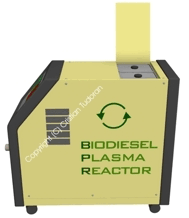

![]()
Our project has two major objectives:
1) The design, building and testing of a portable biodiesel microreactor for the experimental production of biodiesel fuel at small scale
2) Development and testing of a method for plasma treating the surface of polymeric materials (graphite loaded EPDM rubber, polyethylene, etc) for improving their bonding properties.

○ In case of the first objective, the idea is to design, build and test an efficient, fast and portable system that in the near future could enable farmers to produce a cleaner-burning diesel fuel substitute on their farms using seed crops they grow on their own land. Current biodiesel production methods involve dissolving a catalyst, such as sodium hydroxide, in alcohol, then agitating the alcohol mixture with vegetable oil in large vats for two hours. The liquid then sits for up to 24 hours while a slow chemical reaction occurs, creating biodiesel and glycerin, a byproduct that needs to be separated. This glycerin can be used to make soaps, but first the catalyst in it must be neutralized and removed using hydrochloric acid, a tedious and costly process. A microreactor based on the effects of high frequency cold plasma eliminates the mixing, the standing time and the need for a dissolved catalyst.
In case of the biodiesel production in cold plasma reactors, the high energetic electrons are expected to replace the conventional chemical catalyst during the transesterification reactions. The transesterification reaction assisted by cold plasma can be described by the following equation:
Vegetable Oil + Methanol + Plasma (electrons and active species) ▬▬► Methyl Ester + H2.
The reaction suggests that there is no soap formation during the process. The non-thermal plasma being a highly reactive environment, a shorter reaction time is expected compared to the conventional transesterification process, which requires more than 60 minutes to complete. The other advantage of a plasma reactor technology for bio-diesel production is the easy separation or purification process due to no soap and glycerol formations during the plasma reaction.
○ The second objective is to test and improve a surface activation method for polymeric materials like graphite loaded EPDM rubber, different grades of polyester, based on the effects of high frequency cold plasmas.
The graphite loaded EPDM rubber presents a special problem when it comes to activating
its surface even with the plasma processes. The graphite present in its structure means that the material is electrically conductive, and has a volumic resistivity as low as 0.5 Ohms/cm. For this reason, the rubber sample may become a “third electrode” in the systems where the plasma in maintained between two electrode plates. Also, the risk of short circuit exists which can destroy the high voltage power source. The same problem applies for the microwave plasma systems as well, because the graphite loaded EPDM rubber sample absorbs the microwave energy, rapidly heating itself beyond the degradation temperature. Because of such difficult to solve technical problems and its specific properties, the graphite loaded EPDM rubber can only be plasma treated in a dielectric barrier discharge (DBD) cold plasma system.
Such a surface activation method brings three advantages over the chemical or abrasive surface preparation method: reduction of time of the entire process, eliminates the need to use toxic volatile organic compounds and the surface of the treated material keeps its activated property for a much longer time.
| FINANCIAL DATA | |
|---|---|
| Report date | Budget |
| 15 DEC 2013 | 85.158,00 RON |
| 15 DEC 2014 | 99.549,00 RON |
| 31 OCT 2015 | 61.053,00 RON |